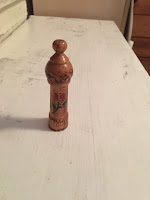This
collage was put together by my grandpa Sam. Sam Leibowitz was my mother’s
father, born in what was then Russia (and is now Ukraine), on an estate where
his father was the overseer. (One reason so many Russian peasants were
anti-Semitic was because so many Russian nobles hired Jews to be their
overseers. Thus, the taxes and other payments due to estate owners were
collected by Jewish men, who bore the brunt of hatred for what the peasants had
to give up.) So the photos are my mother’s family.
On the
left, second from the top, are my parents, Joe and Leah. I think this is from
around the time they got married, though they didn’t have a big ceremony. They
had to wait until she graduated from William and Mary College, in 1940, because
the school (a public institution) didn’t allow married women to be students.
Going
clockwise, the top left corner is another wedding, in 1949. I think the wedding
coupkle, in the center back, are Jeannette and Adolph Blank. Sitting around the
table, from front left, are the bride’s father, Morris (one of Sam’s younger
brothers), Leah with Mark on her lap, Joe with me on his lap, the newlyweds,
Sam, Carla (who must be standing on a chair), Grandma Liz, and the bride’s
mother, Mary.
Next photo
must be Sam’s family. I’m guessing this was taken once they were all in the
United States, coming in at least four different trips: first Sam’s oldest
sister (1905), then Sam (1906), then his next older sister (1907), and then his
mother with three (or four) of her youngest children (1910). On the other hand,
the man on the left looks much older than Sam, so perhaps he is the husband of
Sam’s oldest sister. I may be totally wrong about who these people are, but if
I am, there’s no one to tell me. Here’s my guess: Seated on the right is Sam’s
mother, Yechaved (but she has a different name in the 1910 census), and on the
left perhaps his oldest sister, Rose. Between the two seated women is Sadie, who
looks about 10 here. She died young, at 13; one story says it was on board the
ship New Zealand, but since the 1910 census puts her in the U.S., I think this
story isn’t true. Standing from right: Rose, Sam, Max or Morris or Sol, and if
this is Rose’s husband, that’s Jack Breiman.
In the
upper right corner, this is clearly Sam, perhaps his mother, and Sadie.
In the row
below, from left, the photo that’s labeled 1929 cannot be right. The youngest
girl looks like my mother’s cousin, Honey Lee, who was born in 1930. She might
be two in this photo, which would make Anita, next to her, eight, and Leah,
standing behind, 14. The next photo to the right is, I think, Leah when she was
about two, and that may be her grandmother in the window. This looks like the
country, but I have no idea where. And on the far right, from the right, Leah’s
mother, Liz; an unhappy-looking seven-year-old Leah; Sam, holding baby Anita;
and Liz’s parents, Nathan and Rebecca Ohrenstein. This would be around 1925.
Below this
photo is Anita, probably around 30, with a tiny child photo, and below her, Ben
Morreale, her husband for 38 years. Many stories attached to them, which I will
relate elsewhere.
In the
center is a photo of Nathan and Rebecca, and below them, Sam, standing, Liz
with coffee cup, and Leah, between one and two? These two pictures are clearly
studio shots, but if there was an occasion for them, I don’t know what it is.
Immediately
to the left, we’re getting into the modern era: me at about five; my brother,
Mark, at three, and below Mark, sister Carla, at age one. I think these photos
were taken by a photographer wandering through our Brooklyn neighborhood rather
than in a studio. But look, Carla is holding a ball just as Leah is almost 30
years earlier. Do studio photographers still use that prop for tots?
To the
right of baby Carla are two pictures from 1960, in Gladwyne. On the left, Mark,
me, and Carla are in front of the back of our new house, and on the right is
after my high school graduation, with Grandpa Sam holding our enormous tiger
cat, parents to my left, Mark in the back, and Carla with a hand on the cat.
Below Ben
is a studio shot of Sam’s mother and one of his sisters. To the left is toddler
Leah, around two(?), with her three grandparents, and parents standing in the
back. The wedding couple are, I think, the same couple as in the photo at the
top, Jeannette and Adolph Blank. And to their left, another 1960 graduation
photo, this time with Liz instead of Sam included.
The bottom
row of photos is less known to me. Who is the man in the lower-left picture? To
his right is my mother’s cousin Honey Lee, in the beret, and the date in the
photo below her is clearly wrong: Honey looks about 10, so this would be about
1940. Next to her is her grandmother, and behind her, her father, Morris
Rappaport, and mother Esther, Liz’s younger sister. The next photo is another
mystery, either one of Sam’s sisters or one of his brothers, and presumably
their daughter. And could the date be as wrong as some of these others?
The final
three snapshots: Milly, married to Lou (Liz’s younger brother), and Esther, Honey's mother.
This is one
introduction to part of my family.







